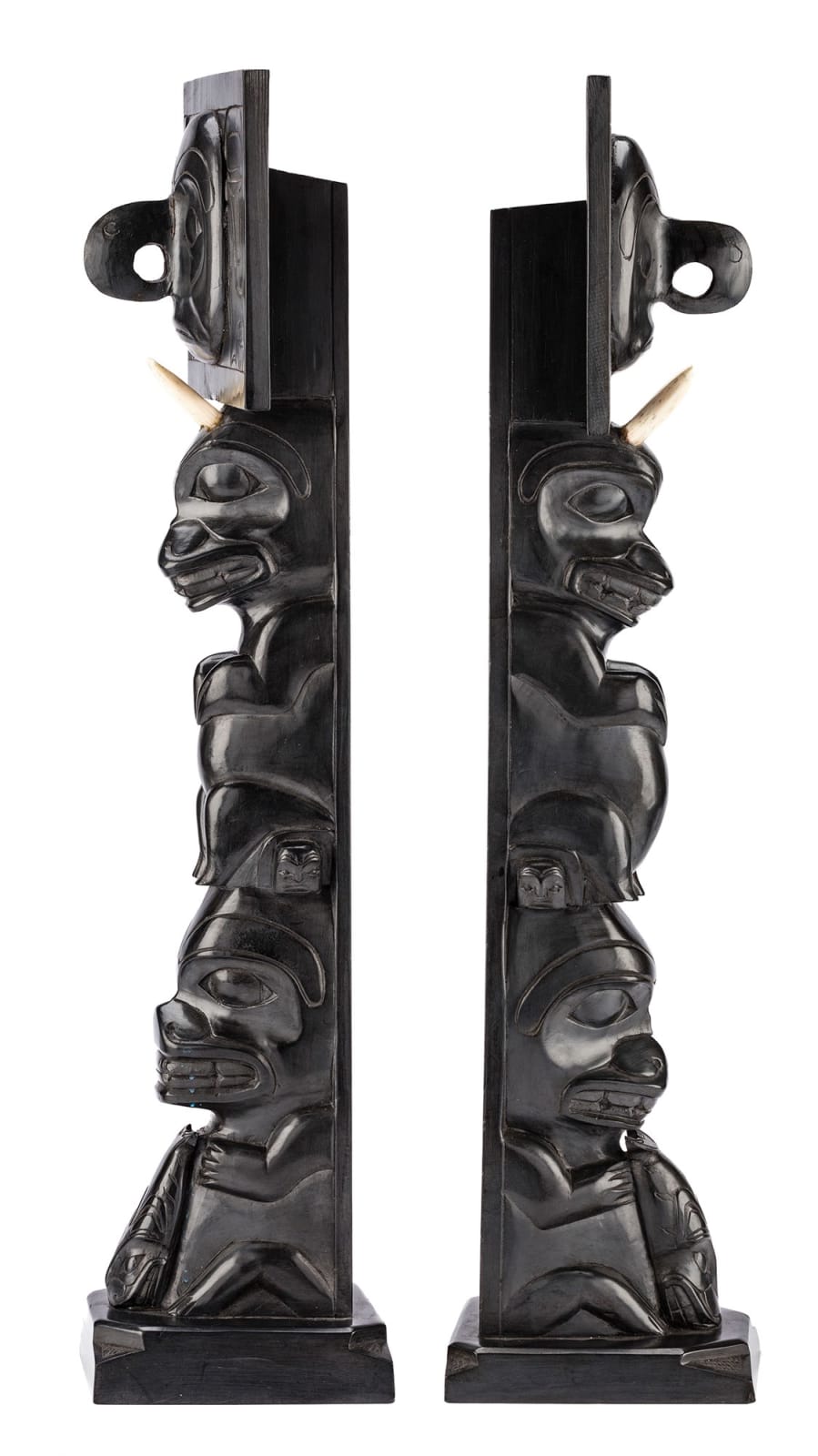-
Artworks
RUFUS MOODY, C.M. (1923-1998) SKIDEGATE, B.C.
Pair of Model Mortuary Totem Poles, 1973each argillite and antler, the first: 20 x 7.75 x 4.75 in (50.8 x 19.7 x 12.1 cm), / the second: 20 x 7 x 4.75 in (50.8 x 17.8 x 12.1 cm);
the first: signed, inscribed, and dated: "Rufus Moody / Skiedgat [sic] Mission / B.C. / © 21/2/73";
the second: signed, inscribed, and dated: "Rufus Moody / Skiedegate [sic] Mission / B.C. / © 3/2/73".LOT 82
ESTIMATE: $15,000 — $25,000
PRICE REALIZED: $13,200.00Further images
These two large model poles (twenty inches tall!) were made as a pair, one after the other, in February and March 1973, by Rufus Moody. By that time, he had...These two large model poles (twenty inches tall!) were made as a pair, one after the other, in February and March 1973, by Rufus Moody. By that time, he had worked through what might be called the “lean years,” those decades in which there were ever fewer artists and argillite carvers among the Haida, mainly due to colonial oppression. Moody became well known around the region for doing the work of carving argillite and maintaining the tradition. Moody was made famous outside his region about this time, in part due to inclusion of his name and work in several art/photo books that came out in the early 1970s. This was an interesting time in Northwest Coast art history; when the last of the old timers who came up through the end of the nineteenth century and the early- to mid-twentieth were still producing traditional work, and a new generation of Native artists was just beginning to thrive and expand the historical tradition, going back to the styles of the early- to mid-nineteenth century to work with and perpetuate what those earlier generations had attained artistically.
Moody was somewhere in between the generations outlined above. He was born after the nineteenth-century masters had already passed (e.g. Edenshaw in 1920), and became famous among a generation whose artistic skills were often below the standards of the traditional masters, yet who maintained a significant foothold on artistic production and maintenance, holding on to cultural arts despite outside pressures and passing on the torch, as it were, to the offspring of a new generation.
These two poles represent what have been called mortuary poles, which at one time held the remains of high-ranking community members in burial chests that rested behind the large horizontal panel(s) at the top of the poles. The ones here are carved to represent a bent-corner chest, with a three-dimensional crest figure at the centre and supporting formline work on each side. The crest appears to be thunderbird, judging by the recurved beak of the sculpture and the representations of wings and feet on the side panels.
The top figures on the vertical portions of these poles are mountain goats, indicated by the horns on their heads, in this case carved of antler. In a reversal of reality, we see white horns on black goats instead of black horns on white goats! The goats are sitting peacefully on top of the lower figures, with their legs and split-toed hooves drawn up in the classic hocker position often seen in this medium. The bottom figures could be bears with salmon, or at another level sea monsters holding whales. Tiny faces are carved in their ears, adding another level of detail to the work. On the backs of the poles, one is hollowed and one is not. This is often an indicator of the time period in which an argillite pole was carved, but in this case Moody refers back to an earlier period in which the backs of poles were commonly hollowed out. The second, flat-backed pole in this pair appears to have shallow marks outlining the area to be hollowed out like the other.Steven C. Brown
References: A historical photo, dated 1878, that includes a very similar mortuary pole, raised for Skedans (head chief at Skedans Village) at Skidegate in 1870, and can be seen in George F. MacDonald’s two important books on Haida art: Haida Monumental Art, ( Vancouver: UBC Press, 1983), pl. 55; and Haida Art, (Vancouver: Douglas & McIntyre, 1996), pl. 123, p. 169. The imagery is essentially identical to that of these two models; Rufus Moody, who was born in Skidegate, would have been familiar with this pole. Interestingly, Bill Reid carved a version of the same pole in Stanley Park, Vancouver in 1964; the formlines on either side of the face appear to be based on that pole. For a monumental and similarly styled argillite Model Mortuary Pole by the artist see First Arts, 14 June 2022, Lot 115.
Provenance
Private Collection, British Columbia.
Join our mailing list
* denotes required fields
We will process the personal data you have supplied in accordance with our privacy policy (available on request). You can unsubscribe or change your preferences at any time by clicking the link in our emails.












